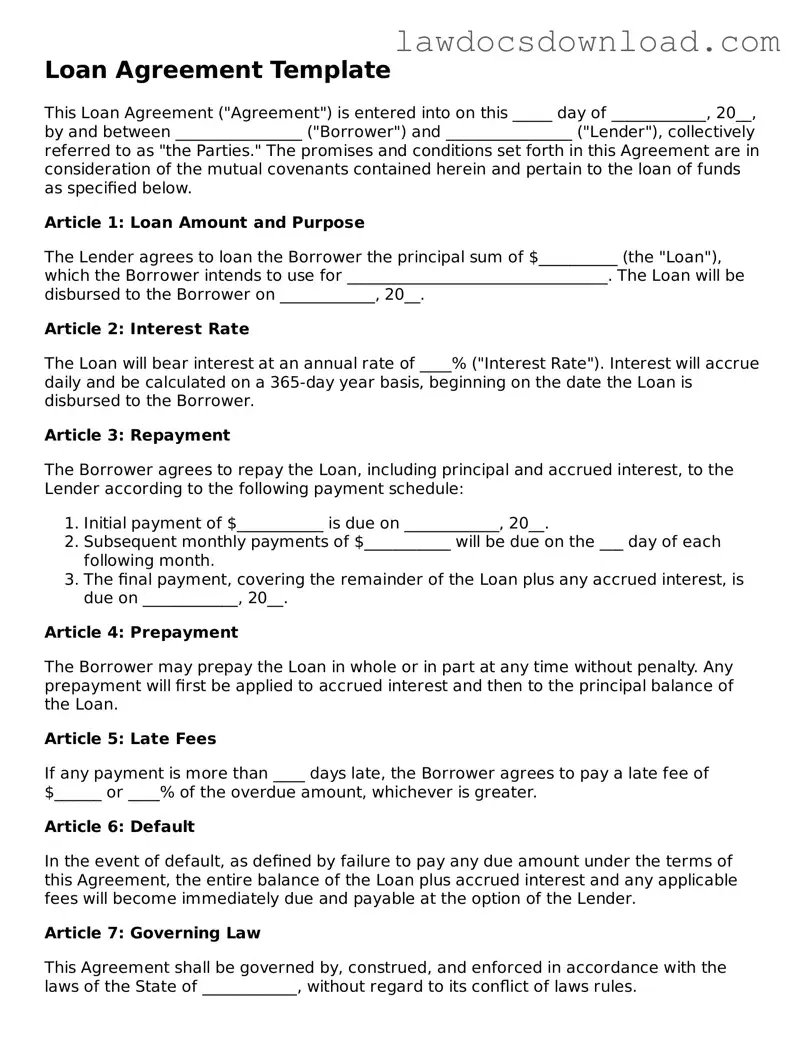Loan Agreement Template
This Loan Agreement ("Agreement") is entered into on this _____ day of ____________, 20__, by and between ________________ ("Borrower") and ________________ ("Lender"), collectively referred to as "the Parties." The promises and conditions set forth in this Agreement are in consideration of the mutual covenants contained herein and pertain to the loan of funds as specified below.
Article 1: Loan Amount and Purpose
The Lender agrees to loan the Borrower the principal sum of $__________ (the "Loan"), which the Borrower intends to use for _________________________________. The Loan will be disbursed to the Borrower on ____________, 20__.
Article 2: Interest Rate
The Loan will bear interest at an annual rate of ____% ("Interest Rate"). Interest will accrue daily and be calculated on a 365-day year basis, beginning on the date the Loan is disbursed to the Borrower.
Article 3: Repayment
The Borrower agrees to repay the Loan, including principal and accrued interest, to the Lender according to the following payment schedule:
- Initial payment of $___________ is due on ____________, 20__.
- Subsequent monthly payments of $___________ will be due on the ___ day of each following month.
- The final payment, covering the remainder of the Loan plus any accrued interest, is due on ____________, 20__.
Article 4: Prepayment
The Borrower may prepay the Loan in whole or in part at any time without penalty. Any prepayment will first be applied to accrued interest and then to the principal balance of the Loan.
Article 5: Late Fees
If any payment is more than ____ days late, the Borrower agrees to pay a late fee of $______ or ____% of the overdue amount, whichever is greater.
Article 6: Default
In the event of default, as defined by failure to pay any due amount under the terms of this Agreement, the entire balance of the Loan plus accrued interest and any applicable fees will become immediately due and payable at the option of the Lender.
Article 7: Governing Law
This Agreement shall be governed by, construed, and enforced in accordance with the laws of the State of ____________, without regard to its conflict of laws rules.
Article 8: Amendments
This Agreement may only be amended, modified, or supplemented by an agreement in writing signed by each party hereto.
Article 9: Notices
All notices, requests, demands, and other communications hereunder shall be in writing and shall be deemed to have been duly given on the date of service if served personally on the party to whom notice is to be given, or on the third day after mailing if mailed to the party to whom notice is to be given, postage prepaid, and addressed to the party at the address stated above.
IN WITNESS WHEREOF, the Parties have executed this Loan Agreement as of the date first above written.
_________________________
Borrower: _________________________
_________________________
Lender: _________________________
